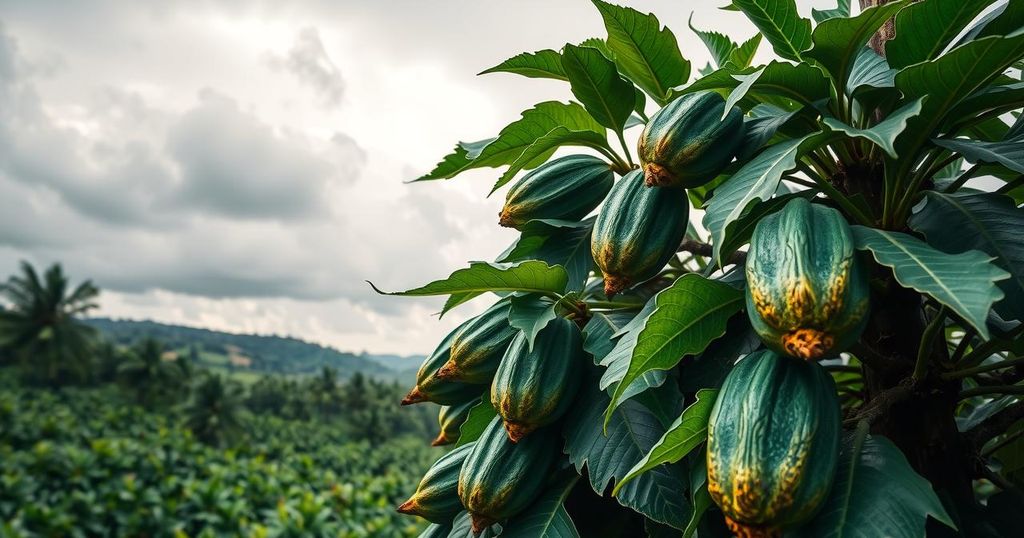A study warns that climate change is harming chocolate supplies by intensifying heat and affecting cacao production in West Africa, which produces 70% of the world’s cacao. This has driven cocoa prices up significantly. The report emphasizes the urgent need for understanding and mitigating climate impacts on agriculture to preserve livelihoods and the environment.
A recent study highlights the detrimental effects of climate change on global chocolate supplies, particularly in West Africa, where approximately 70 percent of cacao production occurs. Farmers face increased temperatures, diseases, and erratic rainfall, all contributing to declining harvests. Consequently, cocoa prices have surged due to constrained production, as the heat exacerbates the challenges faced by cacao trees in the region, including infestations and poor rainfall patterns.
The report, released by Climate Central, indicates that climate change, driven primarily by fossil fuel emissions, is responsible for increasingly hotter temperatures in significant cacao-producing nations like Ivory Coast and Ghana. By leveraging observational data from 44 cacao-producing areas and sophisticated computer modeling, researchers demonstrated that these regions have experienced notably higher temperatures, particularly during the main growing season from October to March. Over the past decade, the study estimates that climate change has resulted in an additional three weeks of extreme heat.
Last year, which holds the record for global temperatures, temperatures exceeded 32 degrees Celsius, or 89.6 degrees Fahrenheit, on at least 42 occasions in two-thirds of the assessed areas. Researchers elucidate, “excessive heat can contribute to a reduction in the quantity and quality of the harvest,” emphasizing the risks associated with climate impacts on cacao farming. The report also noted that various additional factors, such as pest infestations and illegal activities, undermine cacao production.
Christian Aid has released further findings regarding the vulnerability of cacao farmers to the unpredictable weather patterns exacerbated by climate change. Osai Ojigho, the director of Christian Aid’s policy and public campaigns, stated, “Growing cocoa is a vital livelihood for many of the poorest people around the world and human-caused climate change is putting that under serious threat.”
The deterioration in harvests has significantly influenced cocoa pricing, with a dramatic surge evident since late 2023 in trading markets. For instance, cocoa prices in New York surpassed $10,000 per ton, although they have since stabilized below $12,500, contrasting sharply with historical prices that typically ranged between $2,000 and $3,000. To counter increasing cocoa costs, major chocolate manufacturers, such as Lindt & Spruengli, announced plans to raise prices further.
Narcisa Pricope, a professor at Mississippi State University, emphasized that cacao crops are facing an existential threat from increasing desiccation in their growing regions. Recent findings from the United Nations Convention to Combat Desertification indicate that over three-quarters of the Earth’s land has become drier within the last three decades. Professor Pricope noted that greenhouse gas emissions are the primary contributors to this aridity, compounded by practices that degrade soil health.
She surmised, “Collective action against aridity isn’t just about saving chocolate – it’s about preserving the planet’s capacity to sustain life,” underscoring the importance of addressing climate change while also considering agricultural impacts.
In summary, research reveals that climate change poses a severe threat to the global chocolate industry by adversely affecting cacao production in West Africa. The surge in cocoa prices reflects the ongoing challenges farmers face, including extreme heat and agricultural diseases, exacerbated by human-induced climate change. Urgent measures are necessary to mitigate these impacts, not only for the sustainability of cacao farming but also for broader environmental health.
Original Source: www.sciencealert.com






